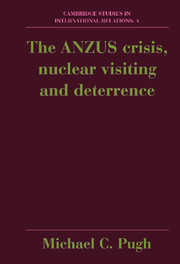Book contents
- Frontmatter
- Contents
- List of tables
- Preface
- List of abbreviations
- 1 INTRODUCTION: THE REVOLT OF AN UNDERLING
- 2 THE ANZUS TREATY AND STRATEGIC DEVELOPMENTS
- 3 DEFENCE CO-OPERATION AND NUCLEAR CONNECTIONS
- 4 WARSHIP ACCESS AND THE ANZAC LIABILITY SUSPENSIONS
- 5 NUCLEAR HAZARDS AND ENVIRONMENTAL SAFETY: ISSUES OF THE 1980S
- 6 ANTI-NUCLEAR POLITICS
- 7 FROM NEGOTIATION TO LEGISLATION
- 8 REGIONAL SECURITY AND THE FUTURE OF ANZUS
- 9 THE ANZUS CRISIS, NUCLEAR VISITING AND THE WESTERN ALLIANCE
- APPENDICES
- Notes
- Bibliography
- Index
3 - DEFENCE CO-OPERATION AND NUCLEAR CONNECTIONS
Published online by Cambridge University Press: 06 July 2010
- Frontmatter
- Contents
- List of tables
- Preface
- List of abbreviations
- 1 INTRODUCTION: THE REVOLT OF AN UNDERLING
- 2 THE ANZUS TREATY AND STRATEGIC DEVELOPMENTS
- 3 DEFENCE CO-OPERATION AND NUCLEAR CONNECTIONS
- 4 WARSHIP ACCESS AND THE ANZAC LIABILITY SUSPENSIONS
- 5 NUCLEAR HAZARDS AND ENVIRONMENTAL SAFETY: ISSUES OF THE 1980S
- 6 ANTI-NUCLEAR POLITICS
- 7 FROM NEGOTIATION TO LEGISLATION
- 8 REGIONAL SECURITY AND THE FUTURE OF ANZUS
- 9 THE ANZUS CRISIS, NUCLEAR VISITING AND THE WESTERN ALLIANCE
- APPENDICES
- Notes
- Bibliography
- Index
Summary
Reporting on the 1983 review of ANZUS, the Australian Foreign Minister, Bill Hayden, recognized the distinction between the Treaty and the defence arrangements which had grown up between the partners, usually bilaterally, and often predating the formal alliance. Although often justified under the rubric of the Treaty, military co-operation was not devised in fulfilment of specific obligations. Recognition of this constituted an evolution in official Australian attitudes to the relationship towards greater pragmatism. During the heated row between New Zealand and the US, Hayden and Beazley encouraged a calmer discussion of the meaning of ANZUS. They downgraded the importance of the ‘guarantee’, and remarked that ‘the day-to-day co-operation’ gave Australia's alliance with the US its significance, compared to the less frequent or binding coincidence of strategic perceptions and interests.
Even without ANZUS, of course, there would exist a high degree of bilateral military co-operation between Australia and New Zealand. As Desmond Ball notes, it reflects an inviolate concurrence of interests. Regular ministerial discussions began in 1972, and these were augmented by the Australia New Zealand Consultative Committee (ANZCC), comprising the permanent secretaries of defence and the chiefs of staff. In 1969 the two governments made an arrangement for maximum self-sufficiency in production and maintenance of equipment. A fully-fledged logistics memorandum of understanding (MoU) of 1983 facilitated progress in several areas: small arms procurement; New Zealand servicing of engines for the RAN's guided-missile frigates; Australian repair of RNZN missiles and torpedoes; and enhancement of trans-Tasman defence communications.
- Type
- Chapter
- Information
- The ANZUS Crisis, Nuclear Visiting and Deterrence , pp. 40 - 60Publisher: Cambridge University PressPrint publication year: 1989



